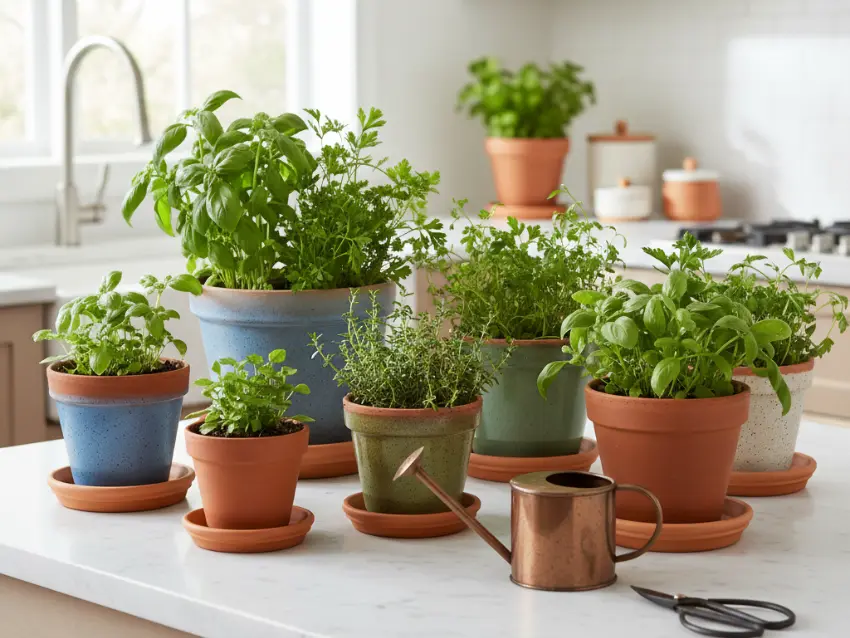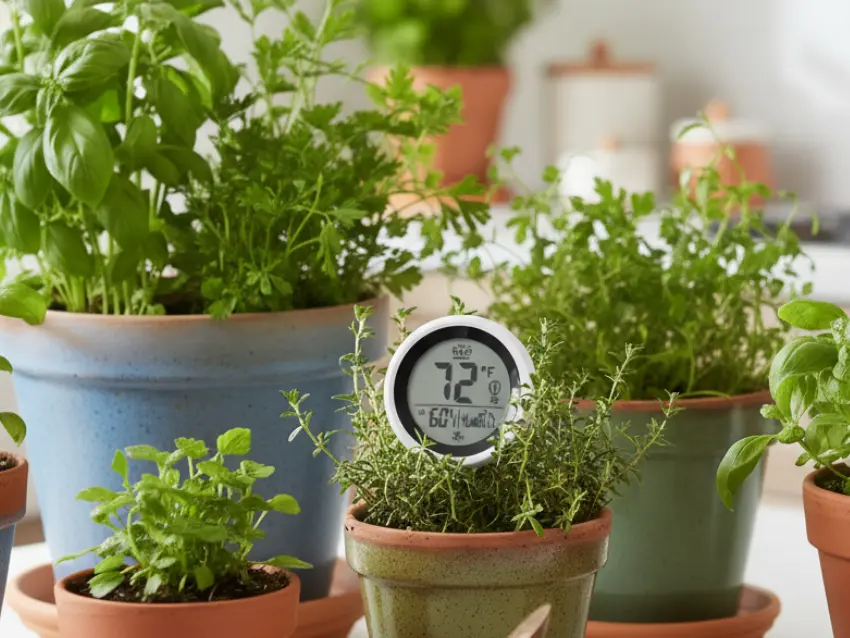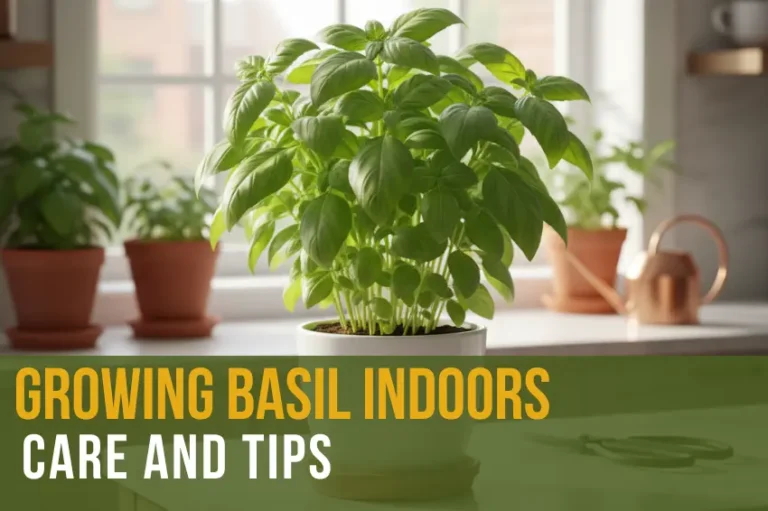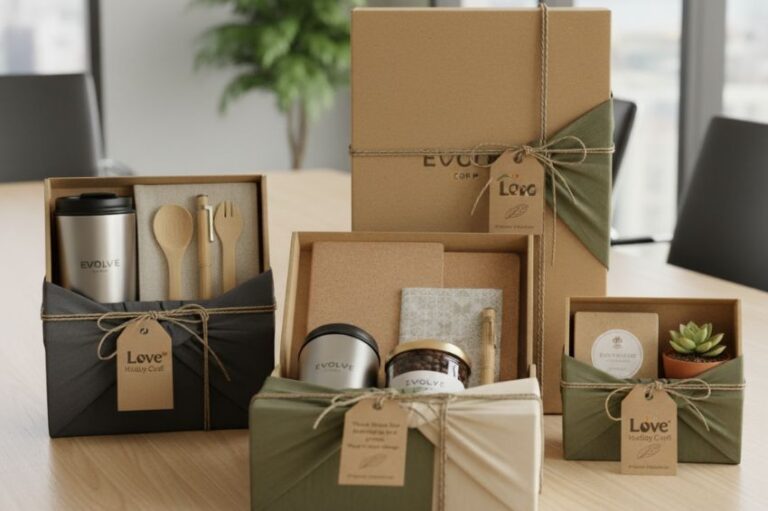Growing herbs indoors isn’t just possible; it’s easier than you think. And trust me, once you get started, you’ll wonder why you ever settled for those sad, wilted supermarket herb bunches.
Whether you’re working with a sunny window or a dim apartment corner, I’ve got your back. Let’s dive into 15 practical, budget-friendly tips that’ll turn you into an indoor herb gardening pro—no green thumb required.
1. Start With Beginner-Friendly Herbs
Not all herbs are created equal when it comes to indoor growing. Some are total drama queens (I’m looking at you, cilantro), while others thrive with barely any attention.
Your best bets for easy herbs to grow indoors:
- Basil: The superstar of kitchen herb gardens. Loves warmth and light. (We have a complete guide on how to grow basil indoors if you want to master this specific herb.)
- Mint: Practically indestructible. In fact, it grows so enthusiastically you’ll want to keep it contained.
- Parsley: Steady and reliable. Takes a bit longer to germinate, but worth the wait.
- Chives: Minimal fuss, maximum flavor.
- Thyme: Handles lower light better than most and doesn’t need constant watering.
Start with these winners, build your confidence, then branch out to the trickier ones like rosemary or cilantro.
2. Understand Your Light Situation (And Work With What You’ve Got)
Here’s the truth about how to grow herbs indoors: light is everything. Most culinary herbs need 6-8 hours of bright light daily. But don’t panic if your apartment doesn’t face south—we’ve got workarounds.
Natural light options:
- South-facing windows are the gold standard
- East or west-facing windows work well for most herbs
- North-facing? You’ll need supplemental lighting
Low-light herbs that tolerate less sun:
- Mint
- Parsley
- Chives
- Lemon balm
My hack? I rotate my pots every few days so all sides get equal light. Keeps them from getting leggy and reaching desperately toward the window.
3. Invest in Grow Lights (They’re Cheaper Than You Think)
Can I grow herbs indoors without natural sunlight? Absolutely! Modern LED grow lights have become incredibly affordable and energy-efficient.
The GE LED Grow Light runs about $20-30 and is perfect for a small windowsill herb garden. For something more comprehensive, the Click & Grow Smart Garden 3 comes with built-in lighting and automated watering—basically the set-it-and-forget-it option for busy people.
Position your grow lights 6-12 inches above your plants and run them for 12-16 hours daily. I use a cheap outlet timer so I don’t have to remember to turn them on and off.
4. Choose the Right Containers (Size Matters)
What type of containers are best for indoor herb gardening? Here’s what I’ve learned the hard way: bigger is almost always better.
Container guidelines:
- Basil, parsley, cilantro: 6-8 inch diameter pots minimum
- Mint: 8-10 inches (it spreads like crazy)
- Rosemary, oregano: 10-12 inches for mature plants
- Chives, thyme: 6 inches works fine
Must-have feature: Drainage holes. Seriously, non-negotiable. Herbs hate wet feet.
The Bloem Aqua Rite Self-Watering Planter is brilliant for those of us who sometimes forget to water. It has a built-in reservoir that keeps moisture consistent—perfect for herbs like basil that get dramatic when they dry out.

5. Get Your Soil Mix Right
Regular garden soil is too heavy for containers. What works best? A quality potting mix that drains well but retains some moisture.
My go-to soil recipe:
- 60% organic potting mix
- 20% perlite or vermiculite (for drainage)
- 20% compost (for nutrients)
Or save yourself the mixing and grab Espoma Organic Seed Starter Mix—it’s formulated specifically for herbs and vegetables, and one bag lasts forever.
Pro tip: Add a thin layer of small stones at the bottom of your pot before adding soil. Extra insurance against waterlogged roots.
6. Master the Watering Balance
How often should I water my indoor herbs? The frustrating answer: it depends. But here’s how to figure it out.
The finger test: Stick your finger about an inch into the soil. Dry? Water it. Still moist? Wait another day.
General watering frequency:
| Herb Type | Watering Needs | Check Frequency |
|---|---|---|
| Basil, Cilantro, Parsley | Keep consistently moist (not soggy) | Every 2-3 days |
| Rosemary, Thyme, Oregano | Let soil dry between waterings | Every 5-7 days |
| Mint | Likes moisture but not waterlogged | Every 3-4 days |
| Chives | Moderate, consistent moisture | Every 3-5 days |
Water until it drains from the bottom, then empty the saucer after 15 minutes. Sitting water = root rot = sad herbs.
7. Keep Multiple Herbs Separate (Usually)
Can I grow multiple herbs in the same container? Technically yes, but I’d suggest against it unless they have similar needs.
Herbs that play well together:
- Mediterranean herbs: Rosemary, thyme, oregano, sage (all like drier soil)
- Moisture-lovers: Basil, parsley, cilantro (keep soil consistently moist)
Herbs that need their own space:
- Mint: This one’s an aggressive spreader. Give it its own pot or it’ll take over everything else.
The Mr. Stacky Smart Farm Vertical Garden is perfect if you want multiple herbs but limited counter space. Stack ’em up!
8. Provide Good Air Circulation
Stagnant air invites mold, mildew, and pest problems. A small fan making your herbs sway gently isn’t just cute—it strengthens their stems and prevents fungal issues.
The Hydrofarm Active Air 6-Inch Oscillating Fan is whisper-quiet and perfect for indoor setups. Just set it on low and let it run for a few hours daily.
Don’t have space for a fan? Opening a window occasionally works too (as long as temperatures stay above 50°F).
9. Feed Your Herbs Regularly
Container soil depletes nutrients faster than ground soil. Your herbs need regular feeding to stay productive.
Easy feeding schedule:
- Liquid organic fertilizer every 2-4 weeks during active growth
- Half-strength is often enough for herbs (they don’t need as much as fruiting plants)
The Espoma Organic Herb-Tone Fertilizer is specifically formulated for herbs and vegetables. One container lasts months, and it’s gentle enough that you won’t accidentally burn your plants.
10. Harvest the Right Way
This is where growing herbs indoors gets really rewarding. Regular harvesting actually makes your plants bushier and more productive.
Harvesting rules:
- Cut above a leaf node (where leaves meet the stem)—this encourages branching
- Take no more than one-third of the plant at once
- Start harvesting once the plant has at least 6-8 inches of growth
- Morning is best—essential oils are strongest then
For basil, pinch off flower buds as soon as you see them. Once it flowers, the leaves turn bitter. Trust me on this—I learned the hard way.
11. Control Temperature and Humidity
Most herbs prefer temperatures between 65-75°F during the day and slightly cooler at night.
Temperature tips:
- Keep herbs away from cold drafts and heating vents
- A drafty window in winter can stress plants
- Most herbs handle normal household humidity fine
Herbs that love extra humidity:
- Basil
- Mint
- Parsley
A small humidifier nearby helps, or group plants together so they create their own microclimate. The lazy option? Set pots on a tray filled with pebbles and water (just don’t let the pot bottoms touch the water).

12. Watch for Common Pests (And Deal With Them Fast)
How do I prevent pests and diseases on indoor herbs? Even indoor plants can get unwanted visitors.
Common indoor herb pests:
- Aphids: Tiny green or black bugs on new growth
- Spider mites: Fine webbing between leaves
- Fungus gnats: Little flies hovering around soil
My pest control approach:
- Inspect regularly—catch problems early
- Isolate affected plants immediately
- Try the gentle approach first: Spray with water, wipe leaves with diluted dish soap
- Neem oil spray for persistent problems (it’s organic and effective)
Prevention is easier than cure: avoid overwatering (gnats love wet soil), ensure good air circulation, and keep your herb area clean.
13. Try Hydroponic Growing
Want to level up your indoor herb gardening? Hydroponic systems grow herbs without soil—and they often grow faster and produce more.
Top hydroponic options:
- AeroGarden Bounty Elite: The premium choice. Grows up to 9 herbs, has built-in LED lighting, and basically does everything for you
- Gardyn Indoor Hydroponic Garden: Uses vertical space brilliantly with app connectivity
- Back to the Roots Hydroponic Grow System: Budget-friendly starter option
I was skeptical at first, but my basil in the Click & Grow Smart Garden 3 grows twice as fast as my soil-grown plants. The initial investment pays off if you use a lot of fresh herbs.
14. Rotate Your Crops
Here’s something nobody tells beginners: herbs don’t last forever indoors. Most annual herbs (basil, cilantro, parsley) will naturally decline after 4-6 months.
My succession planting strategy:
- Start new plants every 6-8 weeks
- This ensures you always have productive herbs at different stages
- Use the Burpee Complete Kitchen Garden Kit to make starting new plants super easy
Keep older plants for continued (though slower) harvests while your new plants mature. You’ll never run out.
15. Keep a Journal (Sounds Dorky, But It Works)
Seriously, jot down what works and what doesn’t. When did you plant that basil? How often are you watering? When did you last fertilize?
Track these basics:
- Planting dates
- Watering frequency
- Light conditions
- First harvest date
- Problems and solutions
After a few months, you’ll notice patterns specific to your space and conditions. It takes the guesswork out and makes you look like a total herb-growing genius.
Setting Yourself Up for Year-Round Success
Growing herbs indoors all year round isn’t rocket science—it just takes a bit of attention and the right setup. Start small with a few easy herbs, get your light and water situation dialed in, and build from there.
The best part? There’s something incredibly satisfying about cooking with herbs you grew yourself, especially when everything outside is frozen solid. Plus, you’ll save money and always have fresh flavors at your fingertips.
What herbs are you most excited to grow? Drop a comment and let’s swap tips—we’re all learning together.
Frequently Asked Questions
Can I use regular potting soil from my garden for indoor herbs?
I wouldn’t recommend it. Garden soil is too dense for containers and can harbor pests or diseases. Plus, it doesn’t drain well enough for pots. Stick with a quality potting mix—it’s lighter, drains better, and is already sterilized. The few extra dollars are worth avoiding the headaches.
Why does my basil keep getting leggy and tall instead of bushy?
This usually means it’s not getting enough light. Basil stretches toward any available light source when it’s struggling. Move it closer to your window or add a grow light. Also, pinch off the top growth regularly—this forces the plant to branch out sideways instead of just shooting upward.
Is it worth buying seed pods or should I just use regular seeds?
Depends on your style. Seed pods (like those from Click & Grow or Plantaform) are more expensive per plant, but they’re foolproof and eliminate the guesswork. Regular seeds are way cheaper but require more hands-on attention during germination. I use both—pods for herbs I use constantly, regular seeds for experimenting.
My mint took over everything in my mixed herb planter. How do I control it?
Yep, mint is notorious for this! The best fix is to immediately separate it into its own pot. If you really want mint in a mixed container, try the “pot-in-pot” method: keep the mint in a smaller pot and then sink that whole pot into your larger planter. This contains the roots while still looking like everything’s planted together.
How long do herb plants typically live indoors?
Annual herbs (basil, cilantro, dill) typically last 4-6 months indoors before production drops off, though you can extend this with good care. Perennial herbs (rosemary, thyme, oregano, mint) can live for years indoors if you give them occasional dormancy periods and repot when needed. Plan to start fresh annuals every season for best results.
Can I save money by starting herbs from grocery store cuttings?
Absolutely! This works brilliantly with basil, mint, and rosemary. Snip a 4-6 inch stem, remove the lower leaves, and stick it in water until roots form (usually 1-2 weeks). Then plant in soil. I’ve started dozens of plants this way from $3 grocery store herbs. Just make sure they’re organic if possible—non-organic ones sometimes have growth inhibitors.



